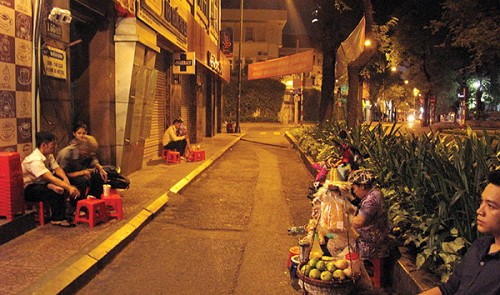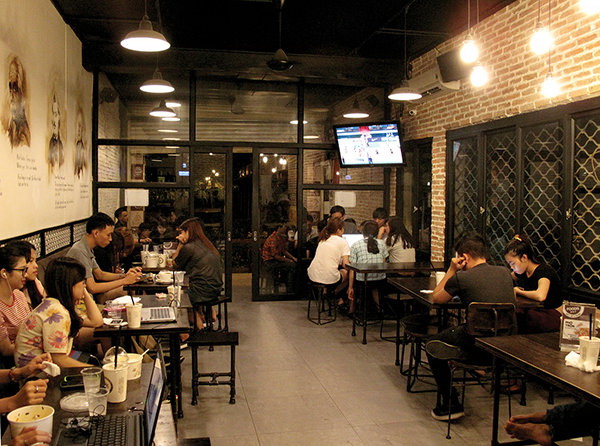Around-the-clock cafés offer glimpses of Saigon by night

At 3:15 am, several customers still relish their coffee and the cozy ambience on the sidewalk in Ho Chi Minh City.
The majority of cafés offering around-the-clock services boast cozy, tasteful interior décor, with ‘makeshift’ chairs dotting the sidewalk in front of the shops.
While those sitting inside mostly work on their laptops, play games or unwind to music, the sidewalk chairs are ideal for couples who crave some privacy, or groups clustering over songs or team games.
Most of these coffee shops are frequented by young artists or youngsters who lead artistic or simply nocturnal lifestyles.
“As designers, we need space and a source of inspiration to work at night. It’s quite dispiriting and unproductive to idle around our stuffy rented rooms. So we just come here for some fresh air and do brainstorming and share our ideas with one another,” Minh Anh, 25, explained how he has grown into a patron at some around-the-clock cafés.
Pham Toan Thang, an emerging young composer, said he often hangs around such cafés once or twice a week.
“Most of my friends are in the artistic circle or those who lead a nocturnal life. We come here to chat, to play ‘Werewolf’ [a currently popular team game among youths] or simply to behold Saigon’s night charm,” Thang divulged, using the old name of Ho Chi Minh City.
He added that he sometimes sits over a coffee cup alone until dawn breaks.
A number of clients at such shops retreat to the relaxing ambience to relieve their anxiety and depression which accumulate from conflicts with their families or at their workplace.
“I’ve frequented around-the-clock cafés for over one year now whenever I fret over my improper education or unstable job. It’s a cheaper and healthier alternative to having drinks overnight,” N.T., 24, confided.
“Lone clients tend to sit for longer hours. Sometimes we want to start a conversation with them, but are afraid that we might be disturbing them,” Nhu Y, a waitress at Thuc Coffee on Pasteur Street, said.
Coffee shops that remain open into the small hours are also a choice popular with young nightshift workers.
Diep Tuan Anh, 24, said he often kills time at such shops to wait for daybreak after leaving his night shift as a militiaman to avoid waking his family up in the small hours.
Around 2:45 am, Duong, Minh and Dung went to Thuc Coffee instead of going home after leaving work at a beer club in District 1.
The friends are regular patrons at the shop.
Attendants
Past 1:15 am, Nguyen Hung Hiep, a 24-year-old barista at The Coffee Factory shop, still had his hands full preparing and serving drinks and working at the counter.
“Our shop has three attendants. We’re busy on weeknights, but things are much more hectic on weekend nights,” he said.

Cafés which remain open into the wee hours are a perfect rendezvous for youths to chat,
idle around, work and do some reading. Photo: Tuoi Tre
Though born in Ho Chi Minh City, Hiep admitted he once marveled at the city’s bustling, alluring night life and the large number of youths who stay up late outdoors after he began working the night shift from 10:30 pm to 6:30 am two months ago.
“It’s tougher working night shifts as we are supposed to stay alert in order not to concoct the wrong drinks. However, this job offers me opportunities to get to know many of my peers, earn some money and hone my bartending skills,” he added.
Tu Duc Thuan, a waiter at another shop, said though it took him almost two weeks to adjust to the nighttime work schedule, he finds it increasingly intriguing.
“Working night shifts helps us stick properly to our daytime school schedule. When we have few clients, I can still take a quick nap or study my lessons,” he said.
However, nighttime attendants also face immense difficulty.
“Customers who are already upset with their own affairs often speak unkindly to attendants. One of my staffers burst into tears after being scolded by one such client,” Nguyen Hoang Ha, co-founder of the Thuc Coffee chain, recalled.
“While most of our daytime clientele is office workers, many of our nighttime customers are rude. When I first began taking the night shifts, I was stressed out by their insolent behavior. But I’m used to them now,” Nhu Y said.
Emerging, annoyance-riddled model
Running around-the-clock cafés has gained in appeal among youths in recent years, but the allure does not come without grievances.
“Many arrive at our shop after leaving discotheques. Under the influence, they demand we raise the volume of our speakers. They also create a mess before stumbling off to sleep. It thus requires a great deal of tact to handle such cases,” Ha, the co-founder of Thuc Coffee, said.
Meanwhile, the owner of another coffee shop in District 1 revealed his shop sometimes receives groups of youngsters who get high on synthetic drugs or discuss schemes to snatch bags or prepare assaults.
The shop owner and staff then politely remind such clients to watch their behavior or silently tip competent agencies off about what they are up to.
When asked whether it is legal to run a café in the wee hours, M., a shop owner, said she had consulted some lawyers who affirmed that rules on operating sensitive businesses are not applicable to coffee shops with no alcoholic drinks, as long as such cafés ensure social order and security.
T., the overseer of a shop, said shop attendants or clients normally do not face such risks as robberies or assaults.
“Such shops are quite crowded, and we make sure that more attendants work at the shop by night than by day. Besides, most shops employ professional security guards,” T. explained.
Tran Hai Anh, 27, said he and his friends, who hang around such shops on a weekly basis, have never been robbed.
According to Nguyen Diep Quy Vy, a lecturer in urban studies at the Ho Chi Minh City University of Social Sciences and Humanities, the emergence of around-the-clock cafés is considered an ‘urban phenomenon.’
“This is indicative of a multifaceted life, individual freedom, diversity of the youth’s recreation forms, and the need to seek outlets for pressure and stress that have been increasingly common among dwellers in large cities,” she noted.
What the stars mean:
★ Poor ★ ★ Promising ★★★ Good ★★★★ Very good ★★★★★ Exceptional
Latest News
More News
- UNIQLO unveils upgraded heat-retention wear at Hanoi event (October 26, 2025 | 10:00)
- Vietnam named among world’s top four culinary destinations (October 24, 2025 | 17:09)
- Vietnam and Denmark strengthen dialogue on sustainable fashion (October 20, 2025 | 09:11)
- Fusion rolls out special initiatives to celebrate Vietnamese Women’s Day (October 17, 2025 | 20:00)
- Showcase AC 2025 set to light up Hanoi stage (September 12, 2025 | 18:06)
- Hotel Indigo Saigon The City hosts event to reimagine city’s beloved alleyways (July 23, 2025 | 17:04)
- UNIQLO’s sustainability strategy behind the brand's global growth (June 23, 2025 | 15:42)
- Vietnam International Travel Mart 2025 kicks-off in Hanoi (April 10, 2025 | 17:50)
- Phu Quoc named as one of Asia's 'Best Islands' (March 13, 2025 | 10:24)
- Lonely Planet lists Ba Den Mountain as must-have Vietnam experience (February 13, 2025 | 14:58)


















 Mobile Version
Mobile Version